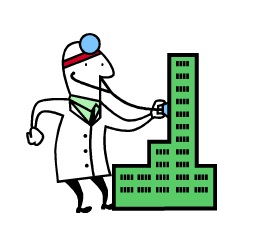 When judges and support staff working in the historic Alberta Court of Appeal building in Calgary began experiencing fatigue, respiratory illnesses and eye, ear and nose irritation, they wondered if the famous building in which they worked was causing their multiple health complaints.
When judges and support staff working in the historic Alberta Court of Appeal building in Calgary began experiencing fatigue, respiratory illnesses and eye, ear and nose irritation, they wondered if the famous building in which they worked was causing their multiple health complaints.So building managers brought in Professor Tang Lee, a University of Calgary specialist in sick buildings, to conduct air sampling. He confirmed high levels of a toxic microbe growing as mould throughout the building. He recommended the building be closed until the toxin is removed.
It turned out that the courthouse was a veritable Petri dish of bacteria, thanks to an improperly installed air intake system. Not only were toxins alive and well and living in the building’s air conditioning, they took up residence and were multiplying in the furniture and carpets — even the court’s files and books. Making matters worse, when judges took files home with them, they inadvertently carried toxins to their residences, in some cases making family members ill.
In effect, the historic building was like a setting for an absurd horror movie: The Spores that Consumed Calgary.
Common problem
In fact, the Appeals Court building problem is not an isolated, one-off incident. Indoor air pollution causes 14-times more deaths than outdoor air pollution according to the World Health Organization. The U.S. Environmental Protection Agency reports indoor air pollution is one of five top environmental threats to human health.
It turns out that many commercial offices are highly toxic environments from the glues, paints, organic chemicals, adhesives and formaldehyde used during construction and finishing. These contribute to indoor air pollution through offgassing that may continue years after new construction or renovations are completed.
The problem is both widespread and deadly: Statistics Canada reports that, in 2003, some 1.3 million people were diagnosed with multiple chemical sensitivities from working or living in what the media dubs “sick buildings.” Since most of us spend roughly 90 per cent of our day indoors, indoor air quality is a serious health risk factor.
Economic benefits
Enter the Canada Green Building Council (CGBC). Although the acronym could be mistaken for an 80s heavy metal band, CGBC actually manages LEED Canada for new construction and major renovations; LEED stands for Leadership in Energy and Environmental Design, a green building rating system.
Among other things it does, LEED sets an indoor environment quality rating including carbon dioxide monitoring, ventilation effectiveness, construction management, using low-emitting materials, indoor chemical and pollutant source control, system controls, thermal comfort, and using daylight to supplant heating, ventilation and air conditioning.
But beyond charts, graphs and reports, LEED has established the economic benefits of healthy buildings. Making general improvements is demonstrated to increase worker productivity for up to 6 per cent. Productivity gains pay for the cost of building and air quality improvements in less than two years.
Fast payback
Why such a fast payback?
Because of the decreasing cost of indoor air quality sensors such as a readily available, multi-gas detector models that cost less than $2,500. They monitor everything from carbon monoxide and oxygen levels to hydrogen sulphide, combustibles and exotic, problem-causing gases such as nitric oxide, nitrogen dioxide, sulphur dioxide, chlorine, ammonia, hydrogen, hydrogen cyanide and chlorine dioxide.
Sick buildings not only produce sick workers, they rob profits from a company’s bottom line — and do so year after year. Yet there are effective, low-cost ways of monitoring an office, factory or warehouse to ensure it stays healthy. They are an easy way to prevent complicated problems.
Isaac Rudik is a compliance consultant with Compliance Solutions Canada Inc., provider of health, safety and environmental compliance solutions to industrial, institutional and government facilities. E-mail Isaac at [email protected] or call him at 905-761-5354. Visit Compliance Solutions website at www.compliancesolutionscanada.com.





